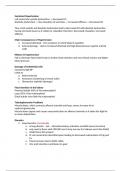Summary
Summary Condensed Notes for PHAR121 Cardiovascular and Diabetes Module
- Course
- PHAR 121 (PHAR121)
- Institution
- University Of Saskatchewan (USask )
Condensed notes covering all material learned in PHAR121 under the cardiovascular and diabetes modules. In-depth material that reinforced the important aspects that will be tested on.
[Show more]



